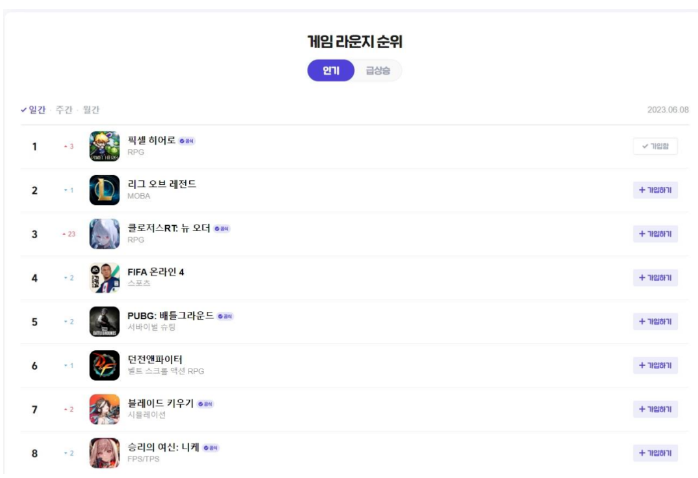Game Gyro, a Chinese game industry blog, contacted Ujoy, a game company using Cocos for their newest game, PIXEL HERO. We have translated part of the story to share with our Western developers.
"The first month's revenue reached 100 million RMB."
"No. 1 on the iOS game bestseller list and No. 5 on the Google Play bestseller list"
This is the latest performance of PIXEL HERO in the Korean market, which was disclosed by Li Longxing, a partner of Ujoy Games, to Game Gyro last week. As this year's "dark horse," PIXEL HERO created a lot of heat when it launched in China, Hong Kong, Macau, and Taiwan at the beginning of this year. Now, under the direction of Ujoy Games, it is blowing up the pixel trend in Korea.

According to Li Longxing, the number of pixel games in the Korean market is very large, and they have a lot more risks in the country, so it is not easy to make a hit game. This time, they have put in a whole lot more effort.
For example, in marketing, they packaged the selling point "One Pick RPG," pushing on the ease of getting into the game, setting up matches and getting upgrades, and focusing on advertising the game a month in advance. The company has invested more than ten million RMB in marketing costs, creating a sense of a masterpiece.
For example, in terms of target user positioning, although they judged that the user group of this product is a general user, it is still centered on male users around 30-55 years old, which they have experienced after a large number of product releases. They want to aim as their main target group.
Ujoy Games, although a "young" company, is already a serial hit maker in the Korean market. Their MMO Light of Zelda and placement card game Solar Revival, released in 2020 and 2022, reached the top 10 of the Korean bestseller charts. Now, they have another masterpiece.
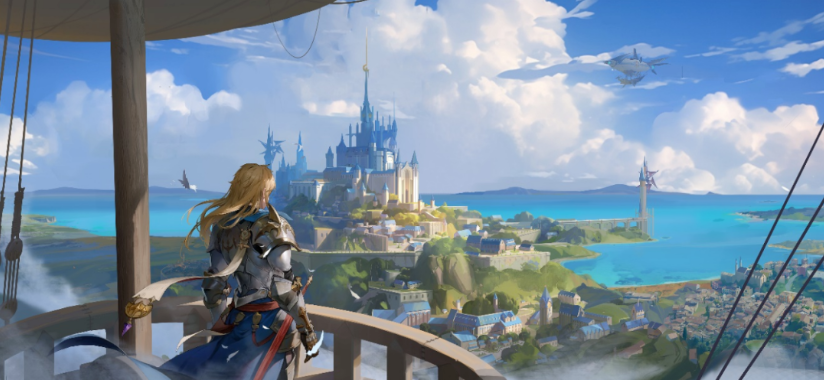
As for the development of Ujoy Games, Li Longxing said that in addition to maintaining the rhythm of releasing several high-quality games every year, they have also opened several self-research projects and customized projects, and the first self-research project will be a globally oriented MMO product, which is currently at 70% completion. They plan to set up a fund to establish more in-depth cooperation with the developers of numerical products.
The following is the conversation:
How does localization work when you break $100 million in the first month's revenue?
Game Gyro: The Korean version of PIXEL HERO has been online for exactly one month. Can you share some of the achievements of this product?
Li Longxing: Our product has already achieved first place in Korea's best-selling list of iOS games, which lasted more than two weeks, and rushed to fifth place for the best-selling Google Play game.
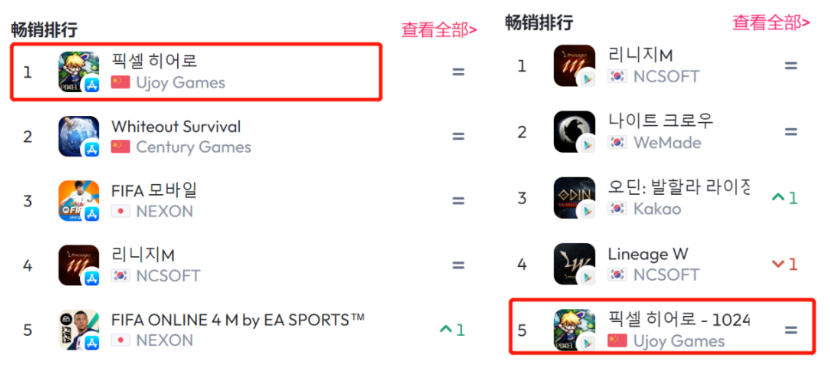
Top sales for June 25 for iOS (left) and Google Play (right)
Because we had already cooperated with Magic Rabbit on Solar Revival last year, we had higher expectations for PIXEL HERO based on the long-term cooperation between the two parties and their respective strengths in the field. Ultimately, it proved that the user scale was much higher than Solar Revival, and the first month's sales reached 100 million RMB.
GG: What were the first-day members?
LL: There were almost 150,000 people on the first day of PIXEL HERO, which is also the highest import volume of our product this year. We spent much effort on the brand, so more than 50% were natural downloads.
GG: You were confident about this release?
LL: Yes, we were actually very confident. First, the tacit understanding with R&D has been cultivated, and our partners have rich R&D experience with these games; second, we understand the product's target user groups and have special resources to verify our ideas in advance; third, both I and the team, have released of more than forty products in South Korea, more than ten years of games, so we know the market and have a deep understanding about the user.
GG: When did you finalize the publishing agreement with Magic Rabbit?
LL: We decided to publish in the Korean market at the early stage of the project. Because they are the publisher of Solar Revival in Korea, Europe, and the United States, the two sides work very well with each other. We also provided the latest market situation to the developers during the project's development.
GG: What is the competitive landscape for pixel-based products in Korea? Can we say it is a blue ocean? (Editor note: Blue ocean refers to an easier but less money-making market compared to a red ocean full of cutthroat and risky business, with big rewards)
LL: We think that there are two main categories of pixel products in Korea: one category of relaxing products, such as "달토끼 키우기 (Placement of the Moon Rabbit)." The other category is PIXEL HERO, which we released this time.
But whether it's cards or pixels, it's not a blue ocean but a red ocean in Korea. There are a lot of similar products in Korea, so it's still challenging to stand out in this market. Not many Chinese manufacturers have gone to the Korean market with this kind of product. When we communicated with Magic Rabbit in the early days, we were looking for what type of art style meets the users' perception in this market and can be loved by the users.
GG: "PIXEL HERO" product localization, you mainly do what adjustments?
LL: Our company's ultimate goal is to make players feel that a local Korean company made this game. Therefore, we not only made some adjustments to the content of the version according to the gaming habits and preferences of Korean gamers but also spent much effort on the rhythm, the frequency and priority of the heroes' output, and the design details of the activities.
For example: because of Korean players, game content consumption speed is relatively fast, generally faster than other regions by 30% -50%. In addition, they are also on the competitive aspects of the content will be more acceptable so that we will target similar aspects. For example, before the launch, there needs to be a good enough depth of content to provide players with more game content to prevent the content from being consumed quickly.
GG: How long did it take to localize this product?
LL: Almost four months, which is still based on the experience of dozens of mature projects in the past. As I said earlier, we have to benchmark the products made by local Korean manufacturers, so the modification and tuning involve language, voice, activities, content version, etc., and many secondary creations. The text of PIXEL HERO is about 800,000 words, and it took two to three months to do the initial translation. I think it's quite rare to find a company that can achieve the quality of a local Korean game with so much content in four months. Still, of course, that's our advantage, as it took about the same amount of time to do it for Dawn of Zelda.
GG: Do you use AI to do localization now?
LL: We are already using it because AI is a big trend, so each of our departments (such as Japanese, European, American, and Korean) will let them use AI, including ChatGPT, which are all in use. However, we mainly only use AI in some content updates, incremental text, or operational text and material production.
PIXEL HERO has not dared to use it on such a large scale. Because AI solves the speed problem, the localization of products like PIXEL HERO, which is very important to us, still gives priority to quality. The localization members of our operation team are basically Koreans. They will use the most accurate and closest to the local game text reading habits to ensure that the quality of the product localization is completely consistent with the local Korean games.
With over 10 million dollars spent in the first month, how do you market the game as a masterpiece?
GG: When it was released in Korea, the slogan for Solar Revival was "God's workplace," and the slogan of Sel's Light was "meeting," meaning meeting a better you. What is the slogan of PIXEL HERO this time?
LL: The point of PIXEL HERO is "One Pick RPG," the game of my choice. When Koreans are faced with an option in every aspect of their lives, such as eating or drinking, they will ask the people around them, "One Pick or Two Picks, which is my first choice?" That's why we use the concept of One Pick. Like "God's Workplace," the product is packaged in Korean culture, so "PIXEL HERO" is a "One Pick RPG" where adventurers choose to resonate with users through this point.
Most big Korean companies emphasize branding, and we do the same thing. Still, we put more effort into branding and communicating with users. All the exposure we do on the branding side is based on the core point of the brand, "One Pick RPG." We combine various branded content with this point to ultimately get players to "One Pick" the game.
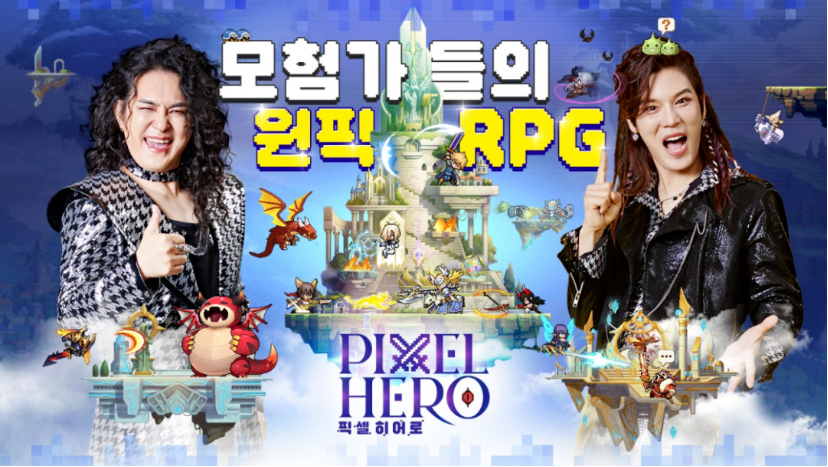
GG: What specifically did the branding side do? And how does it tie in with the One Pick RPG point?
LL: We invited the Korean group Norazo - most people in China may not be familiar with them, but Koreans love their music genre and sense of rhythm. Norazo's song "CIDER" has over 100 million plays on YouTube. Male users in Korea between the ages of 30 and 55 recognize Norazo.
Because pixel style is the favorite style of the 80s and 90s, we want to convey nostalgia, happiness, and trendiness and hope that Norazo's music will "wake up" the players so that they will like it, want to spread it and feel nostalgic when they listen to it. So we adapted Norazo's "CIDER" into the music of "PIXEL HERO" and added the slogan "One Pick RPG" to the lyrics.
The song has a catchy melody, so when users hear it, they will first think that it is a song they have heard before and like it, inadvertently triggering their curiosity. Together with the quite unique pixel style of "PIXEL HERO," it can arouse users' interest.
In terms of branding, we've invested in many subway ads, outdoor ads, and NAVER's Timeboard in Korea - all of which are important methods used by the local big players in Korea.
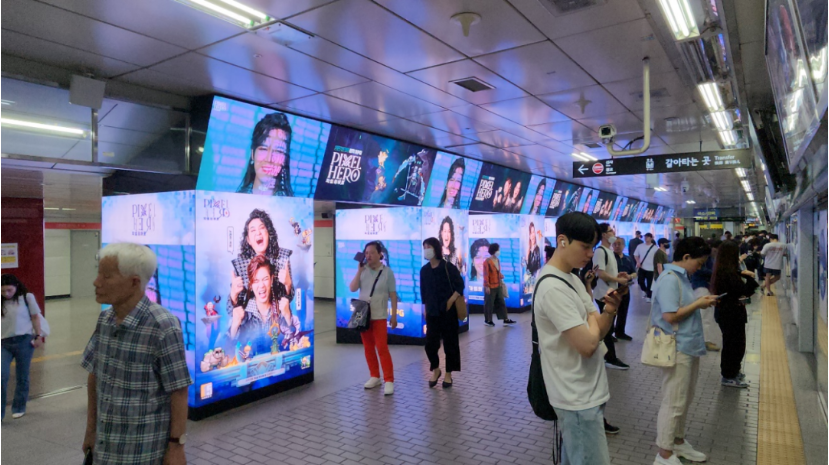
GG: What brand promotion channels are available in Korea?
LL: There are many brand promotion channels in Korea, and the most important media is NAVER, which has many forms of advertisements, such as Timeboard, etc. Other promotion channels include Kakao advertisements, etc. In fact, the difficulty does not lie in the discovery of these channels. The most difficult thing is to have a deep understanding of each channel, a wealth of experience, and a large amount of data to support to ensure that the final effect is to meet expectations. Mindlessly spreading the volume will not have excellent results. We also experienced dozens of project promotions to have the current foundation.
GG: these brand-oriented ads, can you see the real-time conversion?
LL: Not really. That's where the difficulty lies for brands. We also know which brands will have good results based on years of data evaluation, and we can predict how many users it will bring. In fact, in many brands in Korea, such as NAVER ads, you can see as subway ads and display them as outdoor ads. However, the brand and advertising rhythms must be rationally arranged, with closely related and complementary correlations.
The three main channels are Google, Facebook, and TikTok. No matter which company, they all focus on these three channels.
GG: What is your buying rhythm in Korea this time? How is the effect?
LL: Buying volume, this is the place where Chinese manufacturers have an advantage. In this case, we follow the rhythm of the brand, cooperate with the brand's different nodes to make launches, and consume different budgets. The most important of these is the pre-registration period. This time "PIXEL HERO" bought many users during the pre-registration period, so there were 150,000 users on the first day.
The first two weeks basically gain 70,000 to 80,000 users every day. A month has passed, and we still keep adding 10,000 new users per day, and all aspects of the situation are relatively good, so we will continue to buy.
GG: Did you already have such a high budget when you made the plan before launch? Or did you add more slowly because the game performed well?
LL: The budget of over ten million dollars was arranged early. It's mainly based on what I said earlier because both parties trust each other and have confidence in the product. Plus, we have set the distribution strategy of product-performance integration, so we have planned. The branding budget is planned in advance, and the volume buying part is reactive and can be adjusted anytime. This is the efficient part of our team, real-time observation, fast decision-making, and quick adjustment.
The money invested now is not much different from what we had predicted. The biggest difference is that we expected Google Play only to reach the top ten of the bestseller list. However, we rushed to the top five of the bestseller list and are still very happy.
GG: I remember you said it's very difficult for Korean non-MMO products to reach the top of the bestseller list?
LL: It's really very difficult. Many old colleagues in South Korea are saying that there is a "curse" in South Korea. You'll never crack the best-selling list (Google Play) top 7 because the first seven or more apps are South Korean masterpieces built by NC soft, NEXON, Netmarble, and Kakao.
GG: many people's expectations of pixel-style products are relatively low?
LL: Yes. When we were preparing in the early days, we talked to many companies and friends in Korea. They thought it was challenging to package a pixel-style product as a masterpiece and make users recognize it as a masterpiece. But we finally managed to package that sense and add momentum, and many companies and users in Korea recognized it.
GG: Can you say that nowadays, the potential of casual-oriented products in Korea is not smaller than that of heavy products?
LL: Korea is a very mature game market. Users will want to play when they see good products. But relatively speaking, in the Korean market, the game's online rhythm is very fast. You need to keep it hot for as long as you can is important.
Although PIXEL HERO is pixelated, it is still a card placement game. We think the Korean market is still suitable for these products.
GG: What is the main user profile of PIXEL HERO in the Korean market?
LL: Whether it is pixel gamers or card placement gamers, the user group in South Korea is huge. You can see that some of their locals may be partial to the single-player games, but they also have millions of downloads, and the number of products is also a lot.
Our team has accumulated experience in releasing many card products in Korea. We spent a lot of time doing user profile analysis and user research before the project was launched, including collecting and analyzing feedback from users of other products in the market.
In the end, we believe that the user profile of PIXEL HERO is still more in favor of general users.
GG: Will the overall age group of users of PIXEL HERO be younger? Will there be more female users as well?
LL: The basic attributes of Korean game users are more skewed, and PIXEL HERO is also predominantly male. That is, there are still more male users between the ages of 30 and 55. In fact, most of the products we have launched in Korea now are targeted at this age group. It turns out that the core users among the pan-users should still be male users.
GG: What are your next marketing plans?
LL: We are so planned out. We started the brand promotion mainly in Seoul, South Korea, the next will be the second brand promotion to Busan, Daegu, and other second-tier cities in South Korea to expand. Next week, the bus lines, subways, and other important transportation spots in the second-tier cities in South Korea should all be occupied by our ads.
After we did the whole brand advertisement this time, the effect of outdoor advertising is still quite good. So we want to spread it further based on this spot. However, we must pay attention to the routes we choose and see which routes and places are more likely to be seen by more people.
We hope that more users will see PIXEL HERO, that the secondary promotion will arouse more users' interest, and that the probability of staying will be higher.
GG: PIXEL HERO's method of play, compared with our previous release of other products, what are the special differences?
LL: Because PIXEL HERO is an excellent product, we are doing full media exposure in Korea. From TV commercials, including KBS, SBS, and MBC, to subway ads, outdoor ads... Basically, we have placed ads in the most important places in Korea where people gather.
Other than that, it should be the difference in product packaging. Because PIXEL HERO is aimed at a wider audience in terms of game genre and theme, we had to consider how to convey the retro and trendy feel of pixels, as well as the characteristics of Norazo itself, to convey the attributes of PIXEL HERO and the concept of "One Pick RPG" in a way that would resonate with the users. PIXEL HERO" and the concept of "One Pick RPG."
We spend a lot of time on the packaging strategy because every product has unique characteristics and must be integrated with the local culture.
GG: How is it different from other Korean publishers?
LL: We mainly focus on boutique publishing and work with our R&D partners, hoping our products will have a longer lifespan. So, it's especially important to continue to guide the volume.
As I said earlier, we communicate with our R&D partners at the early stage of the project and throughout the entire development process to ensure that the product follows the changes in the market. At the same time, we also pay attention to selecting R&D partners and long-term uninterrupted cooperation and jointly cultivating market knowledge.
GG: Besides doing long-term branding, what is the secret of your success and the principle of doing things?
LL: the team has done more than ten years of games and more than forty projects online. Let me summarize the following points:
First, pay attention to the user feedback of the local market, where we have been spending our efforts; if we want to do a long-term operation, then the management of the game community and the communication between the users become crucial. A good community environment allows users to feel the sincerity of the manufacturer, and after years of doing this, we will also find that there are many benefits for the product; this time, PIXEL HERO reached first place in the Naver game community heat ranking, which is a very, very difficult achievement as a Chinese overseas manufacturer. This reflects the popularity of the game and the high recognition of Korean users for our preparation work in all aspects.
